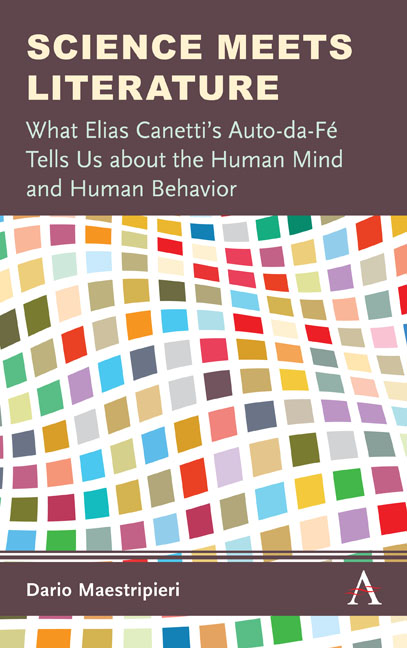 Science Meets Literature
Science Meets Literature Book contents
- Frontmatter
- Contents
- Preface
- Acknowledgments
- Chapter One Why Science and Literature?
- Chapter Two Elias Canetti: A Visionary Literary Genius on a Quest to Understand Human Nature
- Chapter Three The Plot of Auto-da-Fé
- Chapter Four Auto-da-Fé Is a Novel about Human Nature
- Chapter Five Major Themes Running Through Auto-da-Fé
- Chapter Six Analysis of Part I: A Head Without a World
- Chapter Seven Analysis of Part II: Headless World
- Chapter Eight Analysis of Part III: The World in the Head
- Chapter Nine Narrative Strategies in Auto-da-Fé
- Chapter Ten Consilience, the Canetti Way
- Elias Canetti: Chronology
- References
- Index
Chapter Ten - Consilience, the Canetti Way
Published online by Cambridge University Press: 06 July 2019
- Frontmatter
- Contents
- Preface
- Acknowledgments
- Chapter One Why Science and Literature?
- Chapter Two Elias Canetti: A Visionary Literary Genius on a Quest to Understand Human Nature
- Chapter Three The Plot of Auto-da-Fé
- Chapter Four Auto-da-Fé Is a Novel about Human Nature
- Chapter Five Major Themes Running Through Auto-da-Fé
- Chapter Six Analysis of Part I: A Head Without a World
- Chapter Seven Analysis of Part II: Headless World
- Chapter Eight Analysis of Part III: The World in the Head
- Chapter Nine Narrative Strategies in Auto-da-Fé
- Chapter Ten Consilience, the Canetti Way
- Elias Canetti: Chronology
- References
- Index
Summary
The Growth of Consilience
The current sharp division between the sciences and the humanities arguably had its philosophical origin in the mind– body dualism championed by Descartes in the seventeenth century, but it was formally established and strengthened in academia in the twentieth century (see Snow's 1959 discussion of the “two cultures”). Already at the end of the twentieth century, however, there were some calls for abolishing the interdisciplinary barrier and integrating scientific and humanistic approaches, particularly with regard to the study of human behavior. Tooby and Cosmides's 1992 essay, “The Psychological Foundations of Culture,” and E. O. Wilson's 1998 book Consilience were among these early calls. At the same time, the use of evolutionary approaches to interpret literary texts (Literary Darwinism) was also first introduced (Carroll 1995b). Since then, there has been growing interest in consilience. For example, a number of scholarly essays and books on this topic have been published in recent years (e.g., Pinker 1997; 2002; Gottschall 2008a; 2008b; Slingerland 2008; Boyd, Carroll, and Gottschall 2010; Carroll 1995a; 1995b; 2005; Slingerland and Collard 2012; Carroll et al. 2012; Carroll, McAdams, and Wilson 2016), there have been numerous conferences and workshops on this topic, and there is now also a new specialized journal, Evolutionary Studies in Imaginative Culture, which publishes scholarly and scientific articles on literature, film, theater, television, music, religion, the visual arts, and other media, with emphasis on works of imaginative culture that arise out of human nature. The consilience scholars— who come from both the sciences and the humanities— still represent a minority view in the academic community both in the sciences and in the humanities. However, it is a group of highly accomplished, articulate, vocal, and persistent scholars, and the group is constantly growing and recruiting new members. Moreover, included in this group are some well- known public intellectuals such as Steven Pinker.
The integration of science and humanities is a complex issue that can be tackled from different perspectives. For example, Slingerland (2008) has taken a philosophical and epistemological approach, has framed the issue of consilience within a critique of objectivism, mind– body dualism, and postmodernism, and has argued that embodied cognition— which emphasizes the bidirectionality and mutual interdependence of mind and body— provides a particularly promising basis for integrating scientific and humanistic approaches to knowledge production.
- Type
- Chapter
- Information
- Science Meets LiteratureWhat Elias Canetti's Auto-da-Fé Tells Us about the Human Mind and Human Behavior, pp. 173 - 180Publisher: Anthem PressPrint publication year: 2019


